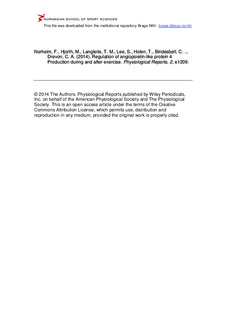| dc.contributor.author | Norheim, Frode | |
| dc.contributor.author | Hjorth, Marit | |
| dc.contributor.author | Langleite, Torgrim Mikal | |
| dc.contributor.author | Lee, Sindre | |
| dc.contributor.author | Holen, Torgeir | |
| dc.contributor.author | Bindesbøll, Christian | |
| dc.contributor.author | Stadheim, Hans Kristian | |
| dc.contributor.author | Gulseth, Hanne Lovdal | |
| dc.contributor.author | Birkeland, Kåre I. | |
| dc.contributor.author | Kielland, Anders | |
| dc.contributor.author | Jensen, Jørgen | |
| dc.contributor.author | Dalen, Knut Tomas | |
| dc.contributor.author | Drevon, Christian A. | |
| dc.date.accessioned | 2014-11-24T10:19:04Z | |
| dc.date.available | 2014-11-24T10:19:04Z | |
| dc.date.issued | 2014-08-19 | |
| dc.identifier.citation | Physiological Reports. 2014, 2, e12109 | nb_NO |
| dc.identifier.uri | http://hdl.handle.net/11250/226351 | |
| dc.description | © 2014 The Authors. Physiological Reports published by Wiley Periodicals, Inc. on behalf of the American Physiological Society and The Physiological Society.
This is an open access article under the terms of the Creative Commons Attribution License, which permits use, distribution and reproduction in any medium, provided the original work is properly cited. | nb_NO |
| dc.description.abstract | Angiopoietin-like protein 4 (ANGPTL4) may regulate lipoprotein lipase-dependent plasma clearance of triacylglycerol from skeletal muscle during exercise. The aim of this study was to examine the importance of muscle in regulating ANGPTL4 in response to exercise. We sampled muscle biopsies and serum before, immediately after, and 2 h after 45 min of ergometer cycling. Sampling was done before and after a 12-week training intervention in controls and dysglycemic subjects. Moreover, fat biopsies were taken before and after the training intervention. The regulation of ANGPTL4 was also investigated in several tissues of exercising mice, and in cultured myotubes. ANGPTL4 levels in serum and expression in muscle were highest 2 h after exercise in both groups. Whereas ANGPTL4 was higher in muscle of exercising controls as compared to dysglycemic subjects, the opposite was observed in serum. In exercising mice, Angptl4 mRNA showed both higher basal expression and induction in liver compared to muscle. Angptl4 mRNA was much higher in adipose tissue than muscle and was also induced by exercise. We observed two mRNA isoforms of ANGPTL4 in muscle and fat in humans. Both were induced by exercise in muscle; one isoform was expressed 5- to 10-fold higher than the other. Studies in mice and cultured myotubes showed that both fatty acids and cortisol have the potential to increase ANGPTL4 expression in muscle during exercise. In conclusion, ANGPTL4 is markedly induced in muscle in response to exercise. However, liver and adipose tissue may contribute more than muscle to the exercise-induced increase in circulating ANGPTL4. | nb_NO |
| dc.language.iso | eng | nb_NO |
| dc.publisher | John Wiley & Sons | nb_NO |
| dc.subject | adipose tissue | nb_NO |
| dc.subject | ANGPTL4 | nb_NO |
| dc.subject | exercise | nb_NO |
| dc.subject | skeletal muscle | nb_NO |
| dc.title | Regulation of angiopoietin-like protein 4 Production during and after exercise | nb_NO |
| dc.type | Journal article | nb_NO |
| dc.type | Peer reviewed | nb_NO |
| dc.subject.nsi | VDP::Medical disciplines: 700::Basic medical, dental and veterinary science disciplines: 710::Human and veterinary science physiology: 718 | nb_NO |
| dc.source.journal | Physiological Reports | nb_NO |
| dc.description.localcode | Seksjon for fysisk prestasjonsevne / Department of Physical Performance | nb_NO |
